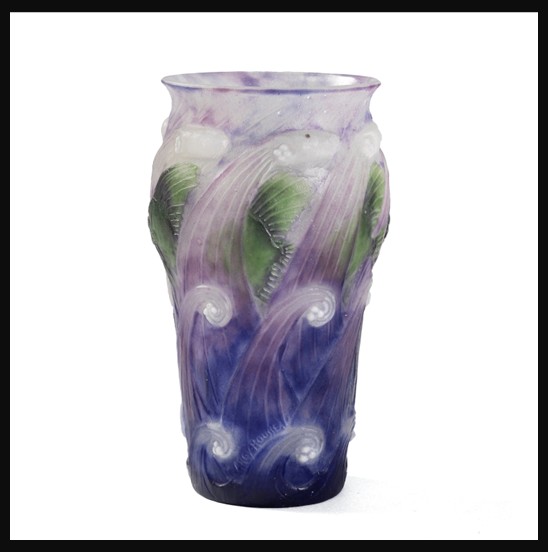
Poissons Dans Les Vagues, 1925, Pâte de Verre Glass Vase, Height: 152.4 millimeters, Macklowe Gallery, NY, USA
https://www.macklowegallery.com/products/gabriel-argy-rousseau-poissons-dans-les-vagues-pate-de-verre-glass-vase?srsltid=AfmBOoovAA26CWovwdBaAjyXP-8bW_rwkBfZTu_V4XvvOPyQAMLEyb-2
When I first encountered Gabriel Argy-Rousseau’s Poissons Dans Les Vagues, I was reminded of Moniza Alvi’s poem Fish Swimming, especially those opening lines about fish drifting in “deep-water coves.” The vase seems to hold a similar mystery: fish suspended in waves, forever moving yet forever still. Like Alvi’s poem, it made me think about the strange distance between ourselves and these creatures, how we can watch them, dream of them, even try to imagine their world, but never truly enter it. There’s poignancy in both the glass and the words, a reminder that, like the fish, we too are bound by time and mortality, always caught between movement and stillness, freedom and fragility. chrome-extension://efaidnbmnnnibpcajpcglclefindmkaj/https://www.teachingenglish.org.uk/sites/teacheng/files/fish_activities.pdf
Argy-Rousseau’s Poissons Dans Les Vagues is a small but captivating pâte de verre vase, standing just a hundred and fifty two millimeters in height. What draws me in immediately is the way the surface comes alive with movement: stylized fish, shaded in tones of green, slip in and out of curling waves that sweep around the form. The glass itself shifts in tone from a light, watery azure at the top to a deeper violet near the bottom, echoing the play of depth and light in the sea. I find the balance of detail and abstraction fascinating, the fish are recognizable, their elongated fins blending seamlessly into the scrolls of the waves, yet they feel part of the rhythm of the whole rather than separate figures. It is a vase that seems to hold both water and motion within its glass, a compact study in fluidity and design.
Born Joseph-Gabriel Rousseau in 1885 in a modest village Meslay-le-Vidame near Chartres, he trained as an “engineer-ceramist” at the École Nationale de Céramique de Sèvres, where an early fascination with chemistry and glass artistry, particularly the pâte de verre technique, took root. In 1913, he married Marianne Perrine Hipathie Argyriadès, a cultured Greek woman whose heritage deeply influenced him: as a tribute, he added the first four letters of her surname to his own and henceforth signed his work ‘Argy-Rousseau’. Her intellectual and cultural background sparked his enduring interest in Greek and Classical art, an influence that would subtly infuse his decorative motifs and lend a timeless, balanced lyricism to his designs.
Argy-Rousseau’s work strikes a compelling blend of scientific precision and poetic artistry. He mastered pâte de verre, a complex, intimate method of glass casting, developing his own streamlined, semi-industrial process that included proprietary coloring techniques such as oxide powder shading before final firing. His early pieces reflect Art Nouveau with their floral, insect, and animal themes, gradually evolving, especially after 1917, into the sharper contours and stylization of Art Déco, while never losing that lyrical touch. His palette ranged from deep ruby reds and amethyst to soft pastels, often in marbled or lustrous gradients, giving his glass a luminous, richly textured surface that seems to glow from within.
Pâte de verre, literally ‘paste of glass,’ is a demanding technique in which finely ground glass powders are mixed with binders, packed into a mold, and then carefully fired so the particles fuse together without fully melting. This process allows for subtle control of color, tone, and translucency, as artists can layer or blend different shades within the mold before firing. In Gabriel Argy-Rousseau’s Poissons Dans Les Vagues, the method is used to striking effect: gradients of pale azure shifting into violet create the impression of depth and water, while tones of green highlight the stylized fish as they weave through curling waves. The surface texture and nuanced shading possible with pâte de verre give the vase a luminous, almost painterly quality, making the fish appear suspended mid-motion within a fluid, glassy sea.
For a PowerPoint Presentation of Gabriel Argy-Rousseau’s oeuvre, please… Check HERE!
Bibliography: https://www.macklowegallery.com/products/gabriel-argy-rousseau-poissons-dans-les-vagues-pate-de-verre-glass-vase?srsltid=AfmBOoovAA26CWovwdBaAjyXP-8bW_rwkBfZTu_V4XvvOPyQAMLEyb-2 and https://www.diamantiques.com/gabriel-argy-rousseau-artiste-technicien-de-la-pate-de-verre/